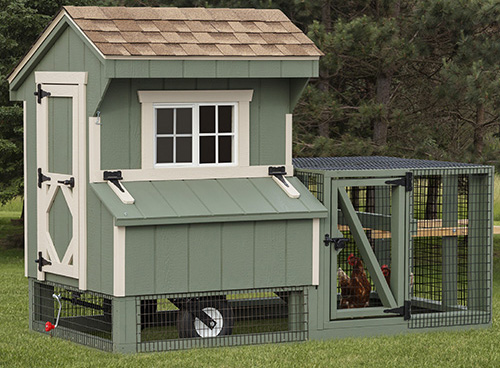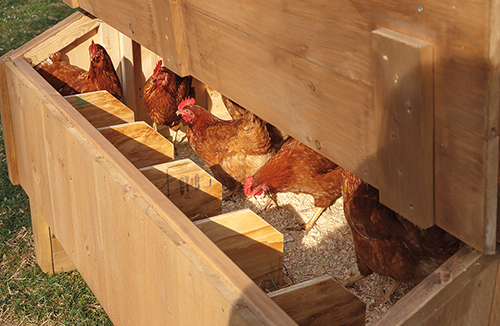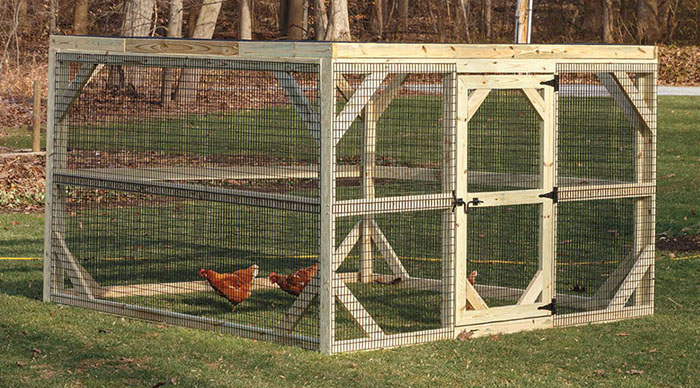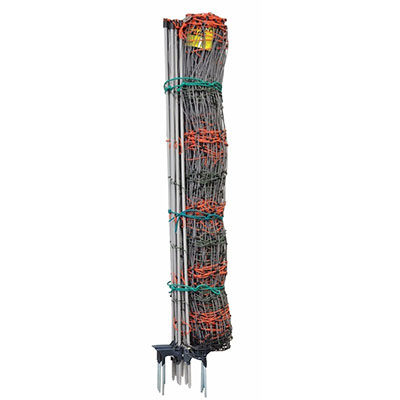
From Rhode Island Reds and Buff Orpingtons to French Black Copper Marans and Bantam Silkies, it is safe to say that we love chickens of all shapes and sizes. As avid chicken enthusiasts, we understand the painstaking care and attention that goes into setting up your coop and run. In this blog, we take a look at coops from every angle, from the roof to flooring, in order to help you decide what options are the best for you and your flock, whether you purchase a pre-built coop or build your own.
The Basics
There are a number of factors that should be taken into consideration when choosing a coop or coop design, although there are certain fundamentals that every coop should have: four walls, a roof, ventilation, nesting boxes, flooring, roosts, and bedding.
Walls: The walls should be airtight, with no holes or cracks. This is especially important so that predators, such as weasels, foxes, and fisher cats are not able to enter the coop. The coop serves to contain your chickens while protecting them from outside interference.
“If your coop is going to be your chickens’ only source of shelter, meaning they won’t have other covered areas to be out of the elements, each standard-sized chicken should have at least four square feet of space inside the coop,” explains Dalia Monterroso, the president and backyard chicken educator of Chickenlandia. “If you have other covered areas outside the coop, like a roofed run or large trees, you can probably get away with two square feet per standard bird. But please, if you are able, build bigger than you think you will need! It’s very likely you will want to expand your flock at some point, and it’s so much easier when you start out with a little more space.”
Roof: A watertight roof keeps your flock protected from both the elements and potential predators. The vast majority of commercially built coops feature a plywood roof covered with a weatherproof material, such as shingles, standing seam metal, or durable plastic roofing. A strong roof is especially important in the New England area or other parts of the country that get significant snowfall in the winter months.
Ventilation: While it is important to have a well-built, sturdy structure, you also need to plan for ventilation and airflow. Proper venting allows for moisture and ammonia gases to escape, which is essential for happy and healthy chickens. This can be accomplished with roof vents, windows, or small holes in the sides of the coop. We recommend that all the ventilation is lined with wire mesh to prevent predators from accessing your chickens in the coop.
The ventilation should be placed high in the coop, preferably well over your chickens’ roosts. The height encourages the most potentially harmful gases and moisture to escape while keeping your chickens out of the elements. Always place cross ventilation in an area that won’t cause a draft where your chickens roost in winter.
“I cannot stress enough how important good ventilation is for your flock!” Dalia exclaims. “In the winter, good ventilation can help to prevent frostbite and respiratory issues (remember: moisture is the enemy, not cold). In the summer, it can be a lifesaver for your chickens to have generous airflow during a heatwave. All year round, good ventilation can prevent dangerous ammonia build up in your coop.”

Nesting Boxes: A safe and cozy place to lay their eggs is essential if you are raising layers. Many chicken owners utilize nesting boxes as a dedicated location. There are many commercial options available, including the Harris Farms Two Hole Nesting Box and the Little Giant Single Nesting Box, which provide your hens with ample room to lay eggs while still giving them privacy. A standard size nesting box measures 12” tall, 12” wide, and 12” long; for larger chickens, such as Jersey Giants, the nesting box should measure 12” tall, 14” wide, and 14” long. Typically, it is recommended that you have at least one nesting box for every five hens that live in your coop. Make sure that you clean the nesting boxes on a regular basis and bed them with shavings or straw to ensure that you have clean and dry eggs.
You want to make sure that the nesting boxes are used solely for laying eggs. “If your chickens are sleeping and pooping in their nesting boxes, you first want to make sure they aren’t having any type of health issue. Check for mites, lice, leg injuries, and everything else. Old age can also make chickens choose comfy nesting boxes rather than roosts, Dalia explains. “Next, you may want to consider changing the design of your coop. Having your nesting boxes lower than your roosts is a great way to encourage chickens to choose the roosts since chickens naturally want to sleep higher for safety and pecking order status.”
Roosts: By nature, chickens want to be elevated on a roost when they are sleeping or resting, since this helps them feel safe and secure. The best roosts are sturdy enough to hold your chickens without bowing underneath their weight. You also want to be certain that there is enough roost space for each chicken, with some extra wiggle room just in case: approximately 15 inches of roost space per chicken is a good rule of thumb. The roosts should be higher than the nesting boxes, but not so high that your chickens (especially elderly chickens) have difficulty getting to them
“You also want to make sure that your roosts are comfortable,” says Dalia. “The most popular recommendation is to make them flat and wide so that chickens can sit with flat feet on them rather than grasping the roost with their toes, but also keep in mind that chickens have been roosting in trees for millennia, so if you aren’t having an issue, don’t scramble to change things.”

Bedding: When it comes to coop bedding, there are many great choices on the market. “What you decide to use [for coop bedding] really depends on how you want to manage your coop,” Dalia says. “If you’re not into scooping poop daily or if you want to utilize the deep litter method, I would suggest going with something absorbent such as hemp, pine shavings, or sawdust. If you’re the type of chicken keeper that prefers to scoop poop daily, you may want to consider sand bedding.”
Pine shavings, like Kaytee Pine Bedding & Litter (for smaller coops) and Richford Wood Products Vermont Pine Shavings (for larger coops), tend to be soft and absorbent, and the natural oils in the pine help to keep the coop smelling fresh. If you are truly concerned about odor, however, we often recommend products like Standlee Flock Fresh Bedding or Koop Clean Chicken Bedding, which contain integrated ammonia control systems.
“Whatever you decide on, it should be something that you can easily keep up with,” she continues. “Your main goal will be to keep ammonia down in your coop and have a sustainable cleaning method for your lifestyle.”
Outdoor Environment

In addition to a coop, your chickens will also need room to stretch their legs and enjoy the sun. Even if you plan to free-range your chickens, it is a great idea to have a confined outdoor space for the winter months or in case of inclement weather. When building your run, there are a number of factors that you should take into consideration, including size, fencing, potential coverings, and entertainment.
Size: The size of your run is a personal preference, but generally larger is better, especially for chickens who do not free-range. A good rule of thumb is to make sure that you have at least ten square feet of space per standard-sized chicken in your enclosed run. It is also important that you are able to access the run in order to clean it out or to check on a sick bird.
Fencing: When selecting the right fencing for your run, it is essential that you look for a material that is not only strong enough to keep your chickens in, but also strong and tight enough to keep predators out. Many chicken experts suggest a mesh chicken wire that is not only strong but also has small enough holes to prevent larger predators from slipping into the run. For increased protection, consider an electrified run, like the Powerfields 82′ Electric Poultry Pen, which has been shown to further deter ground-dwelling predators.

Powerfields 82′ Electric Poultry Pen
This electric poultry pen provides the ultimate predator protection for your chickens.
In order to keep chickens from flying over the fencing, make sure that the fence is at least 6 feet high. Conversely, many chickens love to dig and take dust baths in the dirt. Perform regular checks around the perimeter of your fence line to ascertain that the chicks or chickens are not able to slip under the fencing.
Protective Coverings: “When I first had chickens, I thought the fencing around my run was enough to keep them safe, especially since I always locked them up at night,” says Dalia. “I didn’t realize that there are plenty of critters willing to come during the daytime, especially in the late winter and early spring when their food sources are dwindling. For your peace of mind, if feasible, I would recommend putting strong netting or even roofing over their run. I always say that predators never come, until they do. I wish someone had warned me sooner!” The Rugged Ranch Universal Welded Wire Pen features an included panel along the top of the cage to keep chicks and chickens safe against flying predators.
Entertainment: Bored chickens can often get into mischief; so if you plan to keep them in an enclosed run full-time, make sure to add some enrichment for them to keep them active and entertained. “You can hang a cabbage up for them to peck at, place some dusting boxes around for them, and even put some extra perches around for them to hang out on,” exclaims Dalia. “Watching them ‘play’ with all their things is half the fun of having chickens!”
At The Cheshire Horse, we carry a variety of chicken toys to keep your flock mentally stimulated. The Hentastic Chick Stick Hanging Feeder and the Purina Flock Block are great for food motivated birds and helps them feel as though they are foraging the way that nature intended. We also adore the Fowl Play Chicken Swing, you won’t be able to get enough of watching your chickens swing and play. If your feathered friends would like to venture out of the run, consider a Chicken Walking Harness which keeps your roosters and hens safely contained as you explore your farmyard together.

Purina Flock Block
This whole grain enrichment supplement encourages natural pecking instincts.
“When it comes to keeping chickens, there are a lot of varying opinions on the ‘right way’ to do things,” cautions Dalia. “My advice to new chicken keepers is to always remember that you are embarking on an age-old practice. Chickens and humans have enjoyed a wonderful symbiotic relationship for literally thousands of years. Give them good food, clean water, and clean (but not sterile) shelter, and you’re going to do just fine.”
At The Cheshire Horse, we carry an extensive selection of chicken coops, fencing, bedding, and so much more. In fact, we pride ourselves on having everything you need to successfully raise a flock of poultry. If you have any questions regarding the chicken housing equipment that we carry or would like personalized recommendations on the best chicken supplies for your flock, we encourage you to speak to a member of our friendly and highly experienced sales staff. Many of us are chicken owners ourselves!
